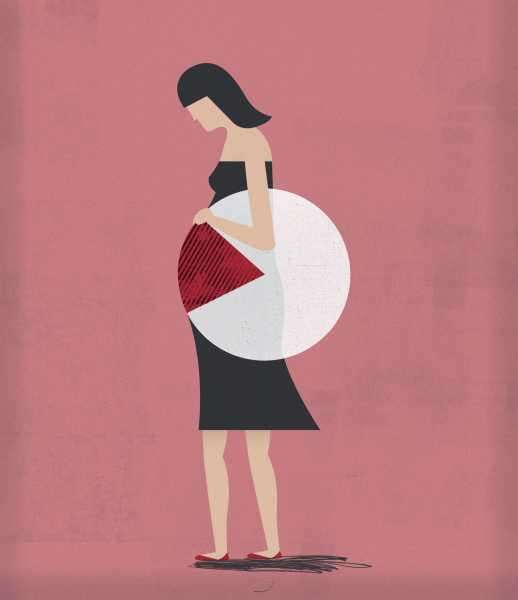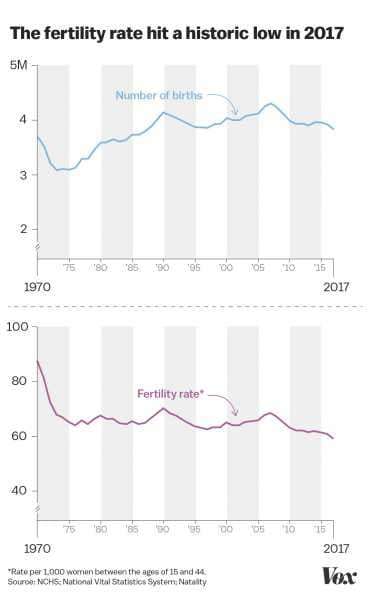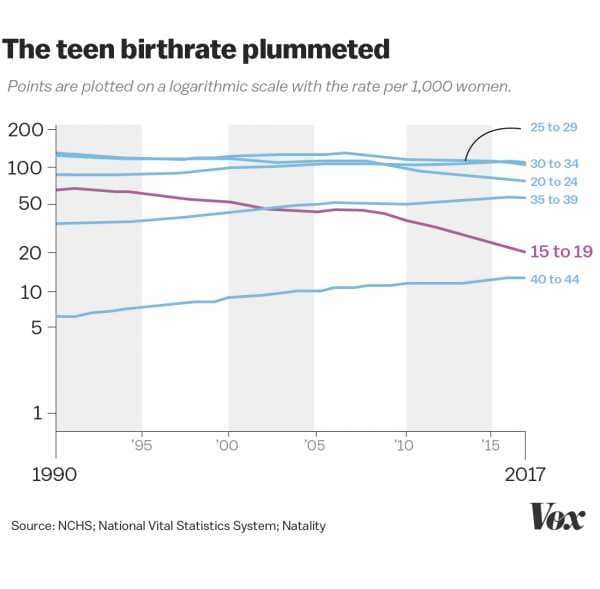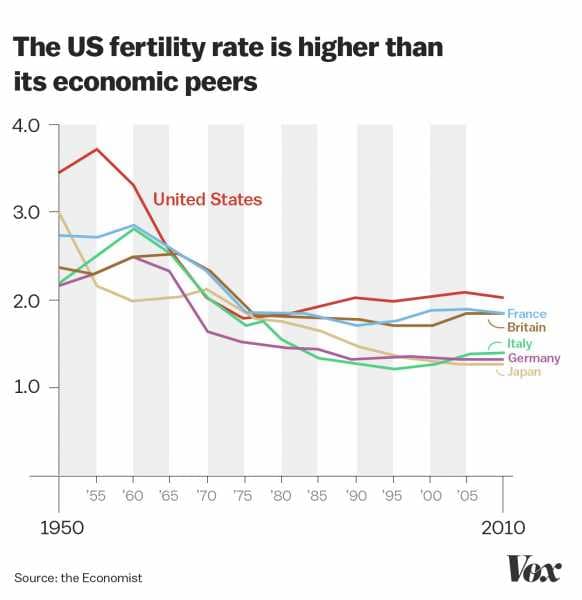
American women are having so few babies these days that the fertility rate has hit a historic low, according to stunning provisional data just published by the Centers for Disease Control and Prevention.
The number of births in the US dropped by 2 percent between 2016 and 2017, to 60.2 births per 1,000 women ages 15 to 44, continuing a general downturn that started with the Great Recession of 2008. It’s the lowest the fertility rate has been in 30 years.

The fertility rate is an important measure of a country’s well-being. When it’s too low, countries worry that in the long term they may not have enough healthy, young workers to keep productivity up and the economy humming. Meanwhile, a birthrate that’s too high can be a drag on resources.
The “replacement” fertility rate of 2.1 — enough to renew the population — is typically viewed as the optimal level for stability. But in 2017, the total fertility rate, or number of births each woman is expected to have in her childbearing years, dropped to 1.76 in the US.
“To put this in perspective, the [total fertility rate] hovered above 3.0 in the early 20th century, declined to replacement levels of about 2.1 in the 1940s; reached a peak of 3.7 in the post-World War II baby boom; and then declined rapidly to relatively stable low levels in the 1970s,” researchers from Columbia University, the University of Illinois, and other universities wrote in a commentary about the new data in the Hill.
It’s not yet clear exactly what’s driving the trend, and the CDC authors don’t offer any guesses. Some, like the economist Lyman Stone, have suggested America’s “historic collapse in childbearing” is being driven by the fact that society isn’t organized to support women having all the babies they’d like to. Others have blamed the economy.
Whatever the cause, the Hill authors warned a low birthrate is another contributor to the “aging society” in the US — where the proportion of the population over 65 is greater than the proportion under age 15 — and that the effects of the low birthrate “will reverberate for years to come.”
But there are also two pieces of good news embedded in the data, especially for women. It turns out the decline in fertility is largely being driven by a dramatic drop in teen births and women joining the workforce. Second, America is simply looking more like its economic peers when it comes to the fertility rate — and that can be partially explained by the drop in unintended pregnancies.
Ultimately, it may be too soon to panic about a “baby bust.” It is time, however, for some sober thought about what social programs and policies are needed to address a demographic shift that is well underway.
A dramatic drop in the teen birthrate and an increase in older moms has nudged the fertility rate down
In the chart below of the new CDC data, you can see the birthrate stratified by the age group of American women. As you might notice, there’s one line that takes a dramatic nosedive. That’s the teen birthrate, which has plummeted by 55 percent since 2007.

There are various reasons for this, as Vox’s Sarah Kliff has explained, but one major one is we have better access to birth control. Women these days are just as likely to be sexually active as they were in the past, Kliff reported, but how they use contraceptives has changed:
So — surprise, surprise! — giving women a technology that allowed them to control their fertility led to fewer teen pregnancies. This dramatic drop in the teen birthrate has contributed to the overall decline in fertility. That’s a very good thing, as the Hill authors remind us: “Children born to teen mothers are more likely to drop out of high school, enter the foster system, end up in prison and use social insurance programs.”
In this chart, you’ll also notice another, related good news story: that the birthrate has actually increased for older moms. Women ages 35 to 44 are more likely to have kids these days than they were 20 or 30 years ago.
“Women want to have a better economic platform from which to launch their families,” said University of Maryland health inequality researcher Philip Cohen. “People who have more to lose invest more in planning and prevention. So the better things are for women, the more they are going to delay their births up to a point and also have fewer births. They have more to lose, they intend to spend more on their children, and the result is fewer children.”
So while delaying childbearing may mean having fewer kids, like the teen birthrate, it’s also a sign of women’s advancement and improved conditions, said John Rowe, a professor of health policy and aging at Columbia’s Mailman School of Public Health and an author on the Hill op-ed. “Women’s participation in the workforce increased delayed pregnancy. So women are having their first child at a later age. And when that happens, the total number of kids they have is fewer.”
The US birthrate is aligning with other rich countries
Another good news story out of the decline in fertility: It’s a sign of economic development.

Poorer countries globally tend to have higher fertility rates. And as you can see here, the US has long had a higher fertility rate than its economic peers. Since the 1970s, the fertility rate has mostly been increasing at a time when the world’s other wealthiest countries have seen their rates stagnate or decline.
The reasons for this were not entirely positive: While economic prosperity and rising immigration played a role, so did an unusually high rate of unintended and single-parent pregnancies relative to other rich countries, said Cohen.
So it’s not all bad that the US is now more in line with its peers; it might mean fewer unintended pregnancies and single moms relative to other countries. Notice, too, that the richest countries have had below replacement fertility for decades. “[They’re] still rich,” Cohen added.
“In the long run, of course, countries with lower fertility are richer more developed countries where women have more opportunities,” he said.
Plus, said William Frey, a demographer and senior fellow at the Brookings Institution, “Even in this extremely low point we are still better off than a lot of other countries.”
It may not be time to panic — but it is time to prepare
So there’s no cause for baby bust panic just yet. If the trend decline continues, however, and we start to hit the low fertility rates of Japan and Italy, the US will need to address the predicaments of advanced aging and losses in the labor force that some of our peers have been experiencing. And this means lawmakers need to grapple with policies that address the demographic shift.
“It’s not ‘the sky is falling’ — but our country needs to adjust to the reduction in the fertility rate,” said John Rowe of Columbia. To do that, he laid out a few potential approaches. “One is keeping older people in the workforce longer. The second is technology — relying on animation, robots and [artificial intelligence] to boost productivity in the absence of workers. A third is increasing immigration. The [final] is boosting the fertility rate,” he summed up.
Keeping older folks in the workforce is probably among the most attractive solutions, Rowe argued, since it keeps people’s minds and bodies engaged and the Social Security trust fund replenished. “But we need to start the processes now,” he added, “because the downturn in the fertility has been going on for several years. And it’s going to take two decades or so to get the policies in place and change employers attitudes.”
We also need to make life better for working moms, argued Caitlyn Collins, a professor of sociology and gender studies at Washington University in St. Louis. “Seventy percent of US mothers work outside the home today,” she said. After having a baby, women need time to recover and care for their baby, as well as “affordable, quality options for child care once they return to work.”
“The US lacks federal provisions for both,” Collins said. “In my mind, leaving it to individual women to find private market-based solutions is insufficient, and it’s part of the explanation for why we’re seeing continuing declines in fertility in the US.” So addressing this for women may not only further improve their status — it could help stabilize the fertility rate too.
Sourse: vox.com






